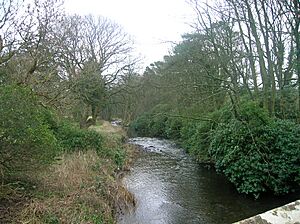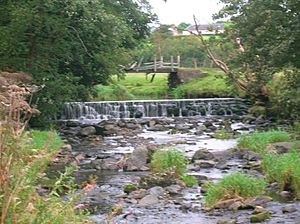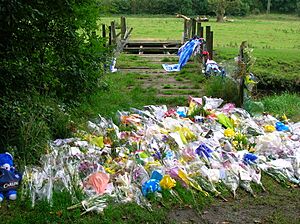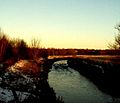Annick Water facts for kids
Quick facts for kids Annick Water |
|
|---|---|

The Annick Water
near Cunninghamhead mill |
|
| Country | Scotland |
| Physical characteristics | |
| Main source | Long Loch (East Renfrewshire) |
| River mouth | River Irvine Irvine, North Ayrshire, Scotland 55°36′14″N 4°39′40″W / 55.60393°N 4.66110°W |
The Annick Water is an important river in Scotland. It's the biggest river that flows into the River Irvine. The Annick Water starts at a place called Long Loch in East Renfrewshire. From there, it flows southwest through North Ayrshire and East Ayrshire. Finally, it joins the River Irvine at Irvine, North Ayrshire on Scotland's west coast.
The river's name might come from a Gaelic word meaning 'overflowing'. This makes sense because the area around the Annick Water, called Strathannick, often experiences floods. The SEPA has records of these floods.
The Annick Water is generally quite clean. A study in the Bourtreehill area in 1999 found many freshwater shrimp. These tiny crustaceans only live in clean water, which is a good sign for the river's health. In 2009, a train carrying fuel derailed near the river. Some fuel spilled, but luckily, the Annick Water avoided major pollution.
Contents
History of the Annick Water

People have used the Annick Water for a very long time. Even Mesolithic people, who lived thousands of years ago, used it as a waterway. Many ancient tools and items from that time have been found along the Annick, especially from Bourtreehill to Dreghorn. In fact, archaeologists found evidence of a very old village near Dreghorn. This village, on the banks of the Annick, might be the oldest continuously used settlement in Europe.
Old Mills Along the River
Many mills used to operate along the Annick Water. These mills used the river's power to grind grain or process cloth. Today, only Cunninghamhead Mill is still standing. Other mills, like Lambroch Mill and Scroaggy Mill (also called Fairliecrevoch Mill), are no longer there. Scroaggy Mill was a 'waulk' mill, which means it was used to thicken cloth. The name 'Scroag' or 'scrog' is an old Scottish word for a crab apple tree or gnarled tree stumps. This name probably described the trees around the mill.
River Crossings and Features
People used to cross the Annick Water in different ways. There were many fords (shallow places where you could walk or drive across) and stepping stones. You can still find these at places like Chapeltoun and Lambroch Mill. A footbridge still exists at Laigh Castleton.
Near Lainshaw House, there was a weir (a small dam) that raised the water level. This created a perfect spot for water birds. A smaller weir is still there under a bridge near Lainshaw Holm. There were also old wooden bridges for carriages on the Lainshaw estate. You can still see the stone parts where these bridges once stood.
Many old bridges cross the Annick Water, including ones at Stewarton and Chapeltoun. In Bourtreehill, you can see parts of a 17th-century bridge. The lower parts of the river were known as Strathannick in the 1700s, but this name is not used much anymore.
Sad Events on the Annick
Rivers can sometimes be dangerous. In the 1500s and 1600s, there was a long feud between two powerful families, the Cunningham and Montgomery families. The fourth Earl of Eglinton was killed at a ford on the Annick near Bridgend in Stewarton.
A gravestone in Dreghorn Parish Church tells the story of a young boy from Perceton who drowned in the river during Victorian times.
More recently, on August 18, 2007, a boy named Dean McGregor from Stewarton fell into the Annick Water when it was flooded. This sad event happened near Lainshaw House. An RAF 'Search and Rescue' helicopter searched the river for many hours. Sadly, the boy's body was found a few days later.
Wildlife of the Annick Water
The Annick Water is home to many different animals and plants.
Animals in and Around the River
- Mink: North American mink have been seen along the riverbanks. These animals were brought to Britain and can be quite aggressive.
- Kingfishers: These beautiful birds are often seen flying low over the water. They are very good at catching small fish with their beaks.
- Eels: Eels are fascinating creatures that start their lives in the Sargasso Sea. Sometimes, especially when it's wet, eels can be seen wiggling across land to take a shortcut over the river's long loops.
- Fish and Invertebrates: The river has a healthy population of fish like Trout and Salmon, along with smaller fish like Sticklebacks and Minnows. You can also find Freshwater Shrimps, Freshwater Limpets, Caddisfly Larvae, Blackfly, Stonefly, and Leeches. All these creatures show that the water quality is good.
- Birds: You'll often see Mallard ducks and herons. Sometimes, you might even spot a Great Crested Grebe.
Plants Along the Riverbanks
The plants growing along the Annick Water are also interesting.
- Liverworts: A plant called Marchantia polymorpha, or Common Liverwort, grows on the bare rocks near Cunninghamhead Mill. This plant is actually quite rare. Other types of liverworts, like Pellia epiphyla and Lunularia, grow on the earth banks.
- Other Plants: The riverside is also home to plants like Butterburr, Reed-Canary Grass, Rushes, Water Forget-Me-Not, Brooklime-Speedwell, Giant Hogweed, Hemlock Water-Dropwort, Willows, and Alders.
Images for kids












